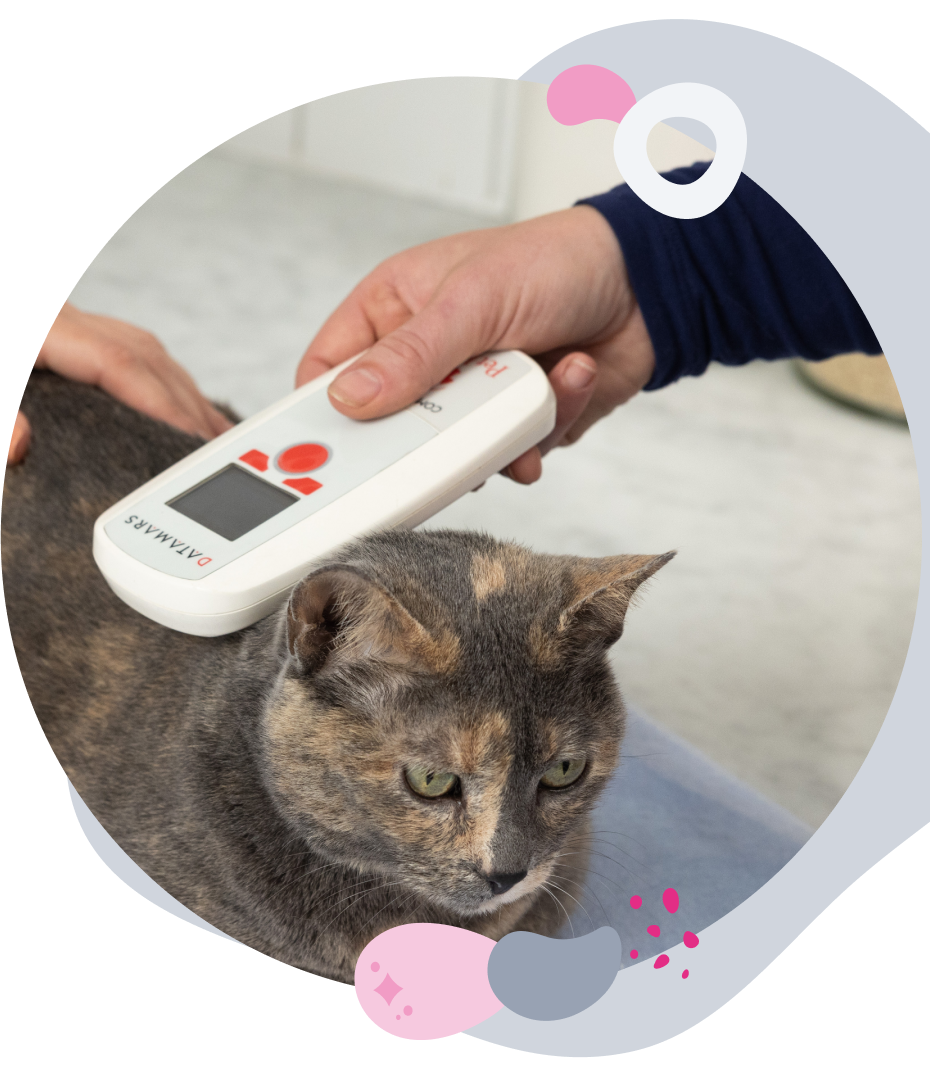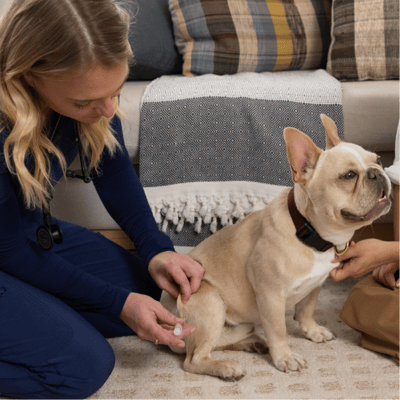
Why BetterVet?
Our mobile veterinarians examine pets in their favorite spot - a comfy couch, a cozy pet bed, or even your lap! See how we work to keep pets relaxed and happy at home.
Pet microchipping is a stress-free, long-term solution to find and identify your pet in case they become separated from you.
Note: Microchipping is typically bundled with a Pet Wellness Exam and requires an additional cost beyond the examination fee.

Take a closer look at the advantages of our in-home microchipping service, designed to prioritize your pet’s comfort and your peace of mind.
Say goodbye to lost tags and collars. All microchips work via RFID technology to provide a permanent and reliable ID for your pet.
Avoid the anxiety and fear associated with veterinary visits and allow your pet to stay in the relaxed environment of their home, making the process stress-free for you and your pet.
Our mobile veterinarians come to you, saving you a trip to the veterinary clinic. Microchipping is a quick process, and can be performed during a scheduled wellness, vaccination, or dental appointment.
You’ll have peace of mind knowing your pets have a reliable tracking method. Each microchip is linked to your contact information, ensuring a secure way to identify your pet.
This section will guide you through the microchipping process from the moment our team arrives at your door to post-care instructions for your pet.

During your selected appointment, our experienced veterinarian will conduct a comprehensive health assessment for your pet. This ensures your pet's overall health is carefully evaluated and addressed during the visit.

Rest assured, your pet's comfort is our priority. The microchip, as small as a grain of rice, is inserted under your pet's skin using a specialized needle. This procedure is typically performed between their shoulder blades where the skin is loose allowing for quick insertion.

Immediately after the implantation, your veterinarian will thoroughly evaluate your pet. We make sure that the microchip is placed correctly and that your pet is feeling comfortable.

We’ll walk you through microchip registration, including registering your pet’s unique ID number. We can recommend a reputable registration service like 24petwatch.com. Your ID is only linked to the contact details you provide, so make sure to update your details if your phone or address changes so that you are reachable.
Microchipping typically takes place during a Wellness Exam or other in-home visit. Wellness Exams start at $99, plus the cost of microchipping and travel. Visit our pricing page for more information and current offers.
| Service | Price Range |
| Service | Price Range |
|---|---|
| Wellness Exam | $99 - 129 |
| Travel Fee* | $89 - $109, depending on location |
| Microchipping | $89.20 |

I have a cat that is a jerk at the vets. I decided to try BetterVet and I was extremely satisfied with them. They were able to calm my baby down, do an exam and insert a microchip in her. Very satisfied with in home service.
The microchipping process is performed as quickly as a typical pet vaccination, no more than a few seconds.
Our microchips are designed to last throughout your pets lifetime so you can rest assured they will be returned to you if they are ever separated.
Other than making sure your pet is relaxed and contained when your veterinarian arrives, there is no preparation needed. Your veterinary team will bring everything they need.
Depending on your location, you may be able to book a wellness or vaccination appointment with microchipping for the same day or the next business day. If you plan to bundle your pet’s microchipping with a dental exam or cleaning, the wait time may be longer.
Whether pet insurance will cover microchipping will depend on your individual plan. We will be happy to provide any records or assistance you need to submit your claim to your insurance company. Please let your veterinarian know what you will need during your visit and reach out to your insurance provider if you have any additional questions.
Similar to a vaccine, your pet’s microchip injection site might be slightly sore for the next 24-48 hours.
Keep your pet as quiet as possible for around 12 hours after the procedure and ensure that the implant site stays clean and dry for 24 hours.
Avoid topical flea and tick treatment one week after your pet’s procedure.
Future vaccinations should be done in a different spot from your pet’s chip.
In the very rare occasion, if a microchip malfunctions, your veterinarian will discuss next steps to ensure your pet is properly microchipped for identification. This typically involves insertion of a new microchip. Because of the high safety margin of microchips, the old microchip is usually left in place instead of pursuing surgical removal.
All of our veterinarians and veterinary technicians are trained and experienced in inserting microchips to your pets.

Skip the traffic by booking a mobile vet visit with one of our trusted veterinarians. We bring full-service vet care to you!